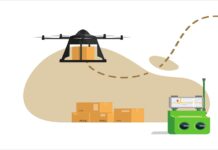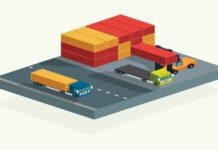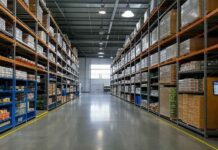While less frequent than at the peak of the COVID-19 epidemic, supply chain interruptions on a local, regional, national, and worldwide scale continue to be a source of worry for manufacturers, their clients, and end users. By using technology, automating processes, and creating resilient relationships, the logistics process has improved in intelligence, speed, and efficiency in order to meet these difficulties.
Automating Tasks
Manufacturers are using automation in the warehouse and extending its usage on the manufacturing line.
For applications ranging from initial input to pallet unitizing, robotics is often the automation instrument of choice. According to an infographic, the majority of consumer-packaged goods (CPG) firms (84%) rely on robots in their operations; by 2027, this percentage is expected to increase to 93%.
Using robots may accomplish a number of objectives:
- Cut down on labor and tedious work
- Boost output and speed
- Attain dependable quality and uniform product management.
- Boost the safety of operators
- Reduce wastage as well as human mistakes.
Modern collaborative robots, or cobots, are quicker, more intelligent, and need less operator experience to deploy successfully since they are less expensive, simpler to build, and much faster overall. Path design, optimization, and running have all been significantly sped by new artificial intelligence (AI) capabilities and increased processing capacity. This has made it possible to place robots in previously unfeasible automation applications like processing, primary packaging, secondary packaging, and transport packaging.
For smaller businesses that are new to robots and want systems that can be installed and operated with no training, there is a greater selection of systems that meet the criteria of the food industry. More user-friendly, human/machine interfaces often come with resident support literature, including schematics, setup and operation instructions, training manuals, troubleshooting tools, and OEM support access. Certain systems may be configured and used immediately out of the box without the need for specialized training. Reprogramming and programming a tablet or smartphone may be completed fast if the operator is acquainted with them. This simple programmability is particularly useful in meeting the growing need for lower quantities and more varied packaging.
Systems with a modular architecture may be expanded to meet changing requirements. More functional end-of-arm tooling (EoaT) can change tools faster, reach deeper, and choose a wider range of forms.
According to the analysis, cobot use will double from 27% in 2022 to 57% in 2027, resulting in especially substantial growth in cobot sales. Adoption will be accelerated by functional advancements including vision, feedback sensors, mobility, self-learning, and AI. Systems are becoming more and more compact, and many of the most recent models are built to carry larger payloads at faster speeds. Certain devices have the ability to automatically transition between conventional and collaborative modes and transfer payloads weighing up to 30 kg. Operators may increase productivity by identifying fault patterns via the gathering of on-board data.
Applications for material handling are growing as more adaptable autonomous mobile robots (AMRs) are developed. Modern AMRs may change their courses to avoid obstacles and maneuver in confined places in dynamic surroundings since they are outfitted with vision systems and 3D LiDAR (light detection and ranging). Having a map makes commissioning faster. AMRs with all-metal bodies are built to endure severe conditions, while narrow-width units maneuver through floor spaces that are limited in size. The ability to charge quickly reduces downtime.
Even with reduced costs and increased interest in robots, the paper points out that adoption still faces obstacles including ROI justification and finding suitable uses. Long lead times and delays in the supply chain; internal shortages (of time, money, and skills); figuring out the total cost of ownership; planning downtime and resources for equipment implementation, training, and performance testing; challenges in finding qualified and unskilled labor; and OEM support for integration, training, and servicing are additional obstacles to robotics implementation.
According to a different research, direct-to-consumer (D2C) business models and labor shortages are driving investments in sophisticated automation technologies in warehouses to improve productivity, quality, and efficiency. With the aid of coding, labeling, and scanning technologies, robotics—especially automated guided vehicles (AGVs) and AMRs—simplifies material handling and helps meet customer expectations for a wider range of SKUs and smaller, more frequent purchases.
Developing Resilience
Manufacturers must always be aware of the whereabouts of their goods as they strive to prevent and resolve supply chain interruptions and satisfy the growing demand for direct-to-consumer shipments. Traceability technology provides insight into production, inventories, and shipments via labeling, scanning, and digital data collection and analysis. This feature enables the following of a product through the supply chain, the detection of any issues, the proactive prevention of delays, the acceleration of product replenishment, and the automation of reordering.
It is possible to identify the correct package for an order, arrange the shipment, and track the package throughout its journey by equipping labels with scannable barcodes, radio frequency identification tags, or near-field communication technology, installing related scanning equipment, and putting data capture and analysis software into practice.
When these technologies are combined, they can:
- Boost corporate openness
- Encourage enhanced performance and more efficient integration across the value chain.
- Allow for novel business concepts
- Encourage and promote sustainability and creativity.
As to PMMI Business Intelligence’s 2023 World Packaging Machinery research, this so-called “smart” packaging may also improve recycling, increase consumer involvement, and provide access to information about the raw materials utilized.
While there are many advantages to implementing traceability and digital inventory management and control internally, employing a third-party logistics (3PL) or fourth-party logistics (4PL) provider may make more sense for smaller businesses or warehouses that aren’t designed to handle D2C shipments.
Numerous shipping, warehousing, and value-added services, including IT integration, order administration, sales support, and customer care, may be handled by a 3PL provider. For CPG companies with many facilities manufacturing various goods, partnering with a 3PL partner is very attractive. According to PMMI’s Packaging and Automation in the Warehouses of the Future research, with 3PL assistance, the producer may send the goods from each facility to the 3PL provider, and orders can be fulfilled from there.
But sometimes, more extensive assistance is required. When that occurs, it’s time to collaborate with a 4PL service provider that can use a network of 3PL businesses to handle the supply chain from beginning to finish. Because of this, up to 50% of D2C shipping for CPG companies uses 3PL and 4PL distribution, and the PMMI research projects that this number will climb.
In fact, according on data compiled by Facts and Factors, the 4PL category already has a dominant position, holding over 62% of the global logistics industry in 2022. The 4PL category is expected to maintain its dominant position until 2028, with a predicted compound annual growth rate of 3.92%.
An advantage of both 3PL and 4PL service providers is that their operations are becoming more and more data-driven. This satisfies the increasing need for package tracking and on-time delivery from CPG firms. A variety of new instruments are being developed to facilitate traceability and lessen fraud, theft, and delivery mistakes. These include smart labels with printed electronics and complex software systems that substitute automated barcode scanning for human barcode scanning.
A partnership with a 4PL service provider offers advantages including quicker fulfillment, cost savings, improved operational efficiency, and accelerated delivery times. Furthermore, as per the research, 4PL service providers have the potential to mitigate overhead, labor, and inventory expenses, eradicate superfluous operations, streamline the supply chain, and augment purchasing leverage by means of an expanded supplier network.

























